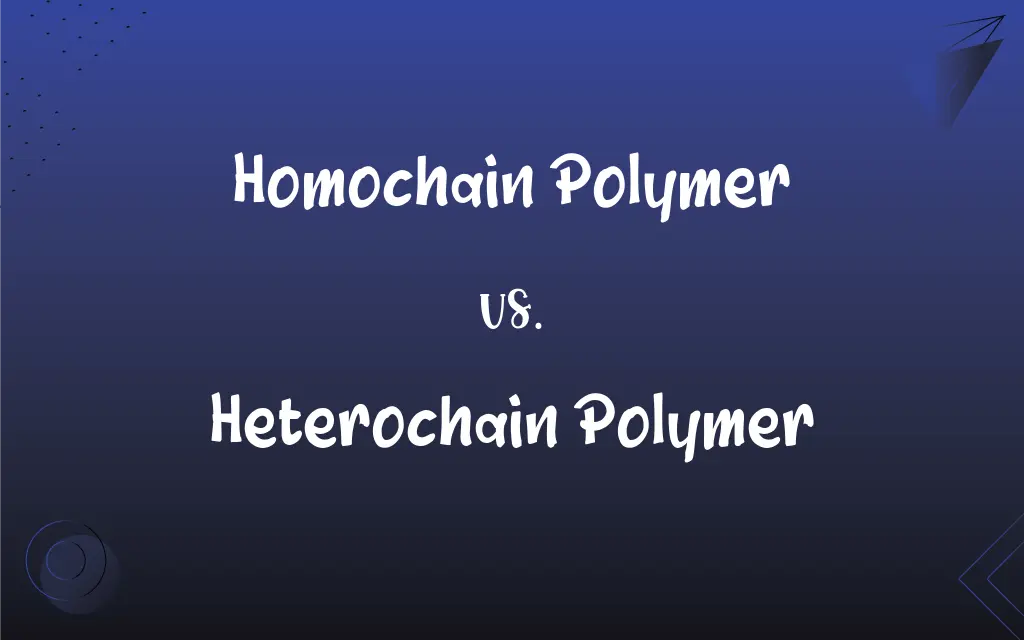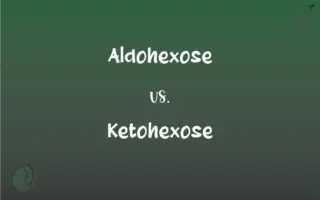Homochain Polymer vs. Heterochain Polymer: What's the Difference?
Edited by Aimie Carlson || By Janet White || Published on May 13, 2024
Homochain polymers consist of repeating units with the same type of atoms in the main chain, while heterochain polymers have different types of atoms in the main chain.

Key Differences
Homochain polymers are characterized by their main chains being composed of a single type of atom, typically carbon. Heterochain polymers, on the other hand, have main chains composed of different types of atoms, such as carbon, oxygen, sulfur, or nitrogen.
In homochain polymers, the repeating units are usually derived from monomers containing carbon-carbon double bonds, leading to polymers like polyethylene and polystyrene. Heterochain polymers are formed from monomers that include heteroatoms, resulting in polymers like polyesters and polyamides.
The properties of homochain polymers are largely influenced by the carbon backbone and the side groups attached to it. In contrast, the properties of heterochain polymers are significantly affected by the presence of heteroatoms in the main chain, which can introduce additional functionalities like hydrogen bonding and polarity.
Homochain polymers are typically more hydrophobic due to the nonpolar nature of the carbon backbone, while heterochain polymers can be more hydrophilic due to the presence of polar heteroatoms. This difference influences their solubility, thermal stability, and mechanical properties.
Examples of homochain polymers include polyethylene, polypropylene, and polystyrene, which are widely used in packaging and consumer goods. Heterochain polymers, such as polyesters, polyamides, and polyurethanes, find applications in textiles, engineering plastics, and biomedical devices.
ADVERTISEMENT
Comparison Chart
Main Chain Composition
Single type of atom (usually carbon)
Different types of atoms (carbon, oxygen, nitrogen, etc.)
Monomer Type
Typically carbon-carbon double bonds
Includes heteroatoms like oxygen, nitrogen, sulfur
Properties
More hydrophobic, influenced by side groups
More hydrophilic, influenced by heteroatoms
Applications
Packaging, consumer goods
Textiles, engineering plastics, biomedical devices
Examples
Polyethylene, polypropylene, polystyrene
Polyesters, polyamides, polyurethanes
ADVERTISEMENT
Homochain Polymer and Heterochain Polymer Definitions
Homochain Polymer
A polymer characterized by its nonpolar carbon backbone.
Polypropylene, a homochain polymer, is used in automotive parts.
Heterochain Polymer
A polymer with a main chain composed of different types of atoms.
Polyethylene terephthalate, a heterochain polymer, is used in making bottles.
Homochain Polymer
A polymer with repeating units of the same atomic composition.
Polyvinyl chloride is a homochain polymer used in pipes and fittings.
Heterochain Polymer
A polymer with additional functionalities due to heteroatoms.
Polyurethane, a heterochain polymer, is used in foam and coatings.
Homochain Polymer
A polymer derived from monomers with carbon-carbon double bonds.
Polystyrene, a homochain polymer, is used in packaging materials.
Heterochain Polymer
A polymer with a main chain that includes atoms like oxygen or nitrogen.
Polycarbonate, a heterochain polymer, is used in eyewear lenses.
Homochain Polymer
A polymer with a main chain consisting of a single type of atom.
Polyethylene is a homochain polymer used in plastic bags.
Heterochain Polymer
A polymer formed from monomers containing heteroatoms.
Nylon, a heterochain polymer, is used in textiles and fabrics.
Homochain Polymer
A polymer with a main chain composed solely of carbon atoms.
Polymethyl methacrylate, a homochain polymer, is used in acrylic glass.
Heterochain Polymer
A polymer with a polar backbone due to the presence of heteroatoms.
Polyacrylonitrile, a heterochain polymer, is used in synthetic fibers.
FAQs
How are homochain polymers typically synthesized?
Homochain polymers are typically synthesized from monomers with carbon-carbon double bonds through polymerization processes like addition polymerization.
What are common examples of homochain polymers?
Common examples include polyethylene, polypropylene, and polystyrene.
What is a homochain polymer?
A homochain polymer is a polymer with a main chain composed of a single type of atom, typically carbon.
What is a heterochain polymer?
A heterochain polymer is a polymer with a main chain composed of different types of atoms, such as carbon, oxygen, nitrogen, or sulfur.
What are common examples of heterochain polymers?
Common examples include polyesters, polyamides, and polyurethanes.
Can heterochain polymers be recycled?
Some heterochain polymers can be recycled, but the process can be more complex due to the presence of different types of atoms in the chain.
Are homochain polymers more hydrophobic or hydrophilic?
Homochain polymers are typically more hydrophobic due to their nonpolar carbon backbone.
What is the main difference in the structure of homochain and heterochain polymers?
The main difference is the composition of the main chain; homochain polymers have a single type of atom, while heterochain polymers have different types of atoms.
How does the presence of heteroatoms affect the properties of heterochain polymers?
Heteroatoms can introduce additional functionalities, such as hydrogen bonding and polarity, which can affect the polymer's solubility, thermal stability, and mechanical properties.
Are heterochain polymers more hydrophobic or hydrophilic?
Heterochain polymers are typically more hydrophilic due to the presence of polar heteroatoms.
How does the molecular structure of homochain polymers affect their mechanical properties?
The molecular structure, including chain length and branching, can affect properties like tensile strength, elasticity, and toughness.
Are there any health concerns associated with homochain polymers?
Health concerns can arise from additives used in some homochain polymers, such as plasticizers in PVC.
How are heterochain polymers typically synthesized?
Heterochain polymers are typically synthesized from monomers containing heteroatoms through condensation polymerization or other polymerization methods.
What are some applications of homochain polymers?
They are used in packaging, consumer goods, automotive parts, and various other applications.
What is the environmental impact of homochain polymers?
The environmental impact varies, but concerns include non-biodegradability and pollution from plastic waste.
How does the molecular structure of heterochain polymers affect their mechanical properties?
The presence of heteroatoms and the resulting functionalities can affect properties like flexibility, thermal stability, and resistance to chemicals.
What are some applications of heterochain polymers?
They are used in textiles, engineering plastics, biomedical devices, and various other applications.
Can homochain polymers be recycled?
Many homochain polymers, like polyethylene and polypropylene, can be recycled.
What is the environmental impact of heterochain polymers?
The impact varies, with concerns similar to homochain polymers, but some heterochain polymers may be more biodegradable.
Are there any health concerns associated with heterochain polymers?
Health concerns can depend on the specific polymer and its applications, with some concerns related to the release of chemicals or degradation products.
About Author
Written by
Janet WhiteJanet White has been an esteemed writer and blogger for Difference Wiki. Holding a Master's degree in Science and Medical Journalism from the prestigious Boston University, she has consistently demonstrated her expertise and passion for her field. When she's not immersed in her work, Janet relishes her time exercising, delving into a good book, and cherishing moments with friends and family.
Edited by
Aimie CarlsonAimie Carlson, holding a master's degree in English literature, is a fervent English language enthusiast. She lends her writing talents to Difference Wiki, a prominent website that specializes in comparisons, offering readers insightful analyses that both captivate and inform.






































































